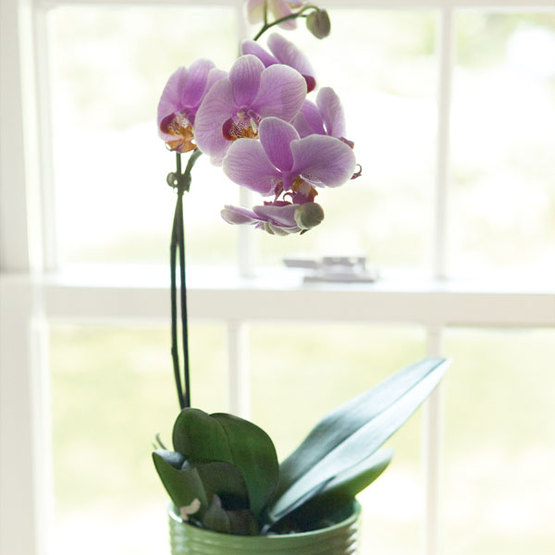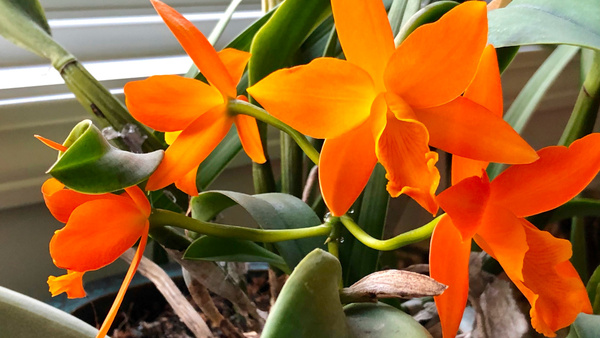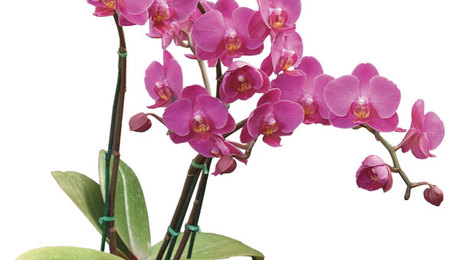
Orchids have a reputation for being finicky. And yet, if you take a trip to your local supermarket or garden store, there are dozens of orchids for $15 apiece, blooming under less-than-ideal conditions. What gives?
The hybrids for sale today have been bred for generations, not only for their big, bright, colorful flowers but also for their toughness, ease of growth, and dependable blooming. The ubiquitous moth orchid (Phalaenopsis spp. and cvs.) has passed poinsettia (Euphorbia pulcherrima and cvs.) as the world’s number one potted plant precisely because it blooms for months at a time and survives under average household conditions. Problems occur, however, when it is treated like any other houseplant.
The bottom line is that orchids aren’t difficult; they’re just different. For starters, most orchids grow epiphytically—that is, aboveground on tree branches or rocks. Their thick, strong roots have adapted to anchoring onto bark or stone, and they are accustomed to the drenching-and-drying routine of tropical rainforests. They need air and space around them, which is why they rot in regular potting mix. In fact, roots are the key to growing healthy orchids. Following these basic care instructions will help ensure that your orchid has the strength to bloom year after year.
Boost energy levels with sunlight

As a rule, moth orchids prefer bright, indirect light—just enough to cast a shadow. This guideline works pretty well, especially when orchids are flowering. But here’s the thing: Once the orchid finishes flowering, it needs energy to produce another flower spike. Just around the time when that spike should begin developing (late fall to early winter), daylight starts getting scarcer in the Northern Hemisphere. So what should you do? Your easiest solution is to move your orchid to a spot where it gets a few hours of direct morning or late-afternoon sun. This will ensure that the plant gets enough energy to make a spike with lots of flower buds. Introduce this stronger light gradually, however—over a week or so. If you think “more light, the better,” think again. Taking an orchid from bright shade to full sun in one day is like going on vacation in midwinter from the streets of Fargo to the beaches of Cancún without suntan lotion. Ouch!
Besides sunlight, orchids also need fertilizer. There are a lot of fancy orchid fertilizers out there, with endorsements from top-notch growers. But the truth is, orchids don’t care about brand names. All they need are regular, light feedings. Orchids can’t absorb as much fertilizer as houseplants that grow in potting soil, and their roots burn if they receive too much fertilizer too quickly. (Remember, there aren’t a lot of nutrients in those tree branches.) So memorize this simple mantra: “Weekly, weakly.” Chant it daily. Post it on your fridge. And once a week, take whatever plant fertilizer you have, and use half the recommended dose when watering your orchids. In winter, cut it back to once a month, and on a monthly basis, wash away excess fertilizer salts by watering your orchids thoroughly in the sink. That’s it. Done.
Never let the potting mix get soggy

Photo/Illustration: Scott Phillips
Most moth orchids do best in a mix of bark, perlite, and charcoal, which drains quickly but stays slightly moist for days. After a year or so, however, this bark mixture breaks down and stops providing the quick drainage and air circulation that orchid roots need. That’s when it’s time to repot. But before you bring a new bag of orchid potting mix to the cash register, pick it up and squeeze it. If it feels soft, like regular potting soil, instead of chunky, like bark mulch, put it back on the shelf. Too often, orchid mix sits around stores so long that it starts breaking down and becomes mushy. Using this old mix will cause your orchid’s roots to rot.
Neglecting to repot, of course, isn’t the only way to end up with soggy mix. Overwatering is the number one cause of death for indoor orchids. When an orchid is blooming, it’s like a new pet: You give it lots of attention. But once the flowers fade, you start forgetting to water. Then, one day, you notice a leaf shriveling or an air root turning brown. To make up for your neglect, you start watering several times a week, instead of only once. A leaf drops; the roots keep shriveling. The orchid isn’t thirsty: It’s drowning, but it looks like it’s drying up. Before you know it, you have a pot of muddy mix and a dying orchid. Don’t let this happen to you. If you want flowers year after year, give your orchid adequate care while it’s in bloom and out of bloom.
How to repot a moth orchid, step-by-step
Water only when the mix is dry, and never let an orchid sit in water. (Orchids are especially prone to root rot and disease when left soaking in water overnight or during the winter months.) To test whether it’s time to water, gently stick your finger about an inch into the mix to check for dampness. When in doubt, wait a few days; orchids handle drought better than flooding.
Cut spent flower spikes for a stronger plant
Give moth orchids warm days and cool nights
Almost everything we do as orchid growers is an attempt to re-create the orchid’s natural habitat. For moth orchids, that means setting the room temperature at a level that is also comfortable for people: between 60°F and 80°F. The hardest thing to achieve indoors, however, is a temperature drop at night of 15°F to 20°F, which is typical in rainforests. Moth orchids, in particular, initiate a blooming spike in response to a month or so of cool nighttime temperatures, which mimics the climate conditions in Southeast Asia at the beginning of its rainy season. At home, you have two options: In early fall, keep your orchid near an open window at night (but don’t let it get below 58°F), or keep the air-conditioning low during the day and turn it up at night.

















Comments
I bought an orchid last night at Lowes, it was soaked sittin in a couple inches of water in the pot, they wasn't takin the right care of these type of plants . when I got home I was doing some research on orchids seeing how to grow them ,then I read "letting them sit in water is the quickest way to kill them" :( I'm hoping it doesn't die,the blooms looks pretty I removed it from that pot an sit in a vase with rocks in the bottom with no water. Do you think the roots will dry up a little an recover and not die ? _ thanks.
I had an orchid given to me last June ,(2016). The flowers gradually died but I've continually watered it little by little over the winter. It's leaves are growing beautifully. I now have 7 extra leaves. I'm just wondering when it will flower again? It sits in the kitchen so it never gets really cold or really hot. Other plants are in the conservatory.
There was no label on it unfortunately to say what type of orchid it was. Can anybody help please?
Indirect sunlight, and give it about 3 ice cubes once a week, or soak it in water for 5 minutes, and feed it monthly when the roots are damp (so you don't burn them)
with a 50% dilute household plant solution
Are there little brown bands around the stems at intervals? I read that you can cut the stems about 1/4" above those, with a razor blade, and sometimes that stimulate the pant to blooming again.
I own one that blooms now and again, no matter whether I cut them or not, it seems
What do I do with the leaves that look somewhat dried-up,
that are under the healthy ones? Nothing? Cut them off?
Orchids grow new leaves from the middle of the plant, and as they do this the old leaves underneath will naturally yellow and dry up. Once they're fully dead, they should just come off if you try to hold them.
Thanks
Log in or create an account to post a comment.
Sign up Log in